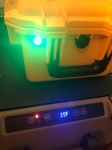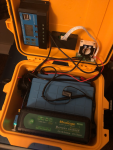Going to assume I am way overthinking this and setting myself up for ridicule but I am struggling with the updates to my setup - Currently, I am running the standard lead-acid primary starting battery w/100-watt rooftop solar setup through a 20 amp solar charge controller to power my Dometic fridge and other minor accessories. Pretty basic and straight forward. Obviously, this isn't ideal and I need an upgrade to not put the strain of 5-8 hrs of fridge consumption on a battery not designed to do this job.
I would love to maintain the ability to still use the solar to keep my vehicle charged when the power pack isn’t in the vehicle since the solar is permanently mounted.
Future setup will include a portable power pack build using a Power Sonic 12.8v lifepo4 45AH battery, 120v inverter, additional 20 amp solar charge controller that is compatible with the lifepo4 battery and all the other trimmings. After reading a lot of what is probably hyperbole on from different articles on voltages and chemistry, I am struggling with how to incorporate it w/out mixing chemistry/voltages while still maintaining solar charging ability for the vehicle as well as the pack being self-sustaining away from the permanently mounted panel on the vehicle. So I am toiling with the idea of two different solar charge controllers in some manner but that just feels like a bad idea unless I come up with a way to isolate which controller is not needed at that moment.
https://expeditionportal.com/forum/threads/charging-lifepo4-from-12v.197220/
I reviewed through this and it basically seems to elude to that if I use an ignition/alt relay to not pull from the starting battery when the ignition is off everything would be fine. I think I could put it in line with the power pack and trigger it from the ignition hot plug in the back of my vehicle. Idle voltage is 13.8-13.9 so I believe I would be fine on that point so all this overthinking might not matter. Just run the +- from my power pack to a 12v relay on my fused run to my starting battery and call it a day.
Any input would be appreciated. Most likely I will just end up having to eliminate/terminate the built in solar controller in the vehicle and run the solar leads to the controller in my pack and use the accessory output from the controller to input back to the vehicle 12v power. Any major repercussions from doing this? The other part of this I haven’t wrapped my brain around is how to charge the power pack from the vehicle while in motion?
I would love to maintain the ability to still use the solar to keep my vehicle charged when the power pack isn’t in the vehicle since the solar is permanently mounted.
Future setup will include a portable power pack build using a Power Sonic 12.8v lifepo4 45AH battery, 120v inverter, additional 20 amp solar charge controller that is compatible with the lifepo4 battery and all the other trimmings. After reading a lot of what is probably hyperbole on from different articles on voltages and chemistry, I am struggling with how to incorporate it w/out mixing chemistry/voltages while still maintaining solar charging ability for the vehicle as well as the pack being self-sustaining away from the permanently mounted panel on the vehicle. So I am toiling with the idea of two different solar charge controllers in some manner but that just feels like a bad idea unless I come up with a way to isolate which controller is not needed at that moment.
https://expeditionportal.com/forum/threads/charging-lifepo4-from-12v.197220/
I reviewed through this and it basically seems to elude to that if I use an ignition/alt relay to not pull from the starting battery when the ignition is off everything would be fine. I think I could put it in line with the power pack and trigger it from the ignition hot plug in the back of my vehicle. Idle voltage is 13.8-13.9 so I believe I would be fine on that point so all this overthinking might not matter. Just run the +- from my power pack to a 12v relay on my fused run to my starting battery and call it a day.
Any input would be appreciated. Most likely I will just end up having to eliminate/terminate the built in solar controller in the vehicle and run the solar leads to the controller in my pack and use the accessory output from the controller to input back to the vehicle 12v power. Any major repercussions from doing this? The other part of this I haven’t wrapped my brain around is how to charge the power pack from the vehicle while in motion?



